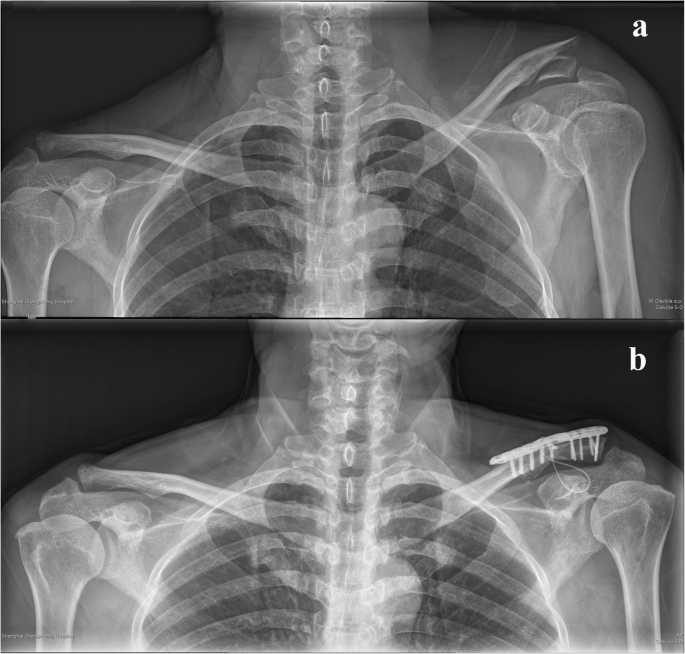Introduction
In the realm of orthopedic surgery, advancements in medical technology have revolutionized treatment options for various fractures and injuries. One such innovation is the Clavicle Locking Plate, a crucial medical device used in the treatment of clavicle fractures. This article explores the ins and outs of the Clavicle Locking Plate, its surgical procedure, benefits, potential complications, and the road to recovery after undergoing this treatment.
What is a Clavicle Locking Plate?
The Clavicle Locking Plate is a specialized medical implant designed to stabilize and fixate fractures of the clavicle, commonly known as the collarbone. These plates are typically made from high-quality materials like stainless steel or titanium, ensuring strength and durability. The primary purpose of these plates is to support the fractured bone during the healing process and facilitate a faster and more stable recovery.

The Evolution of Clavicle Locking Plates
In recent years, orthopedic surgeons have embraced clavicle locking plates as a reliable solution for clavicle fractures. These plates are made of high-quality materials such as titanium or stainless steel and feature specialized locking mechanisms, providing better stability during the healing process.
Indications for Clavicle Locking Plate Surgery
Clavicle fractures are quite common, often occurring due to falls, sports injuries, or motor vehicle accidents. Depending on the severity and location of the fracture, a Clavicle Locking Plate surgery might be recommended by orthopedic surgeons. The surgery is usually indicated in the following situations:
1. Displaced Fractures
When the broken ends of the clavicle are misaligned or displaced, surgical intervention may be necessary to realign and stabilize the bone properly.
2. Complex Fractures
In cases where the clavicle fracture is complex, involving multiple fragments, a Clavicle Locking Plate can provide the necessary stability for effective healing.
3. Non-Union Fractures
If the clavicle fracture fails to heal properly, leading to a non-union, a locking plate can be used to promote bone fusion and healing.
4. Fractures in Athletes
Athletes and individuals with high physical demands may opt for surgical treatment with a Clavicle Locking Plate to ensure a quicker return to their activities.
The Surgical Procedure
The surgical procedure involving a Clavicle Locking Plate is a well-established and effective treatment option for clavicle fractures. Here's an overview of the typical surgical process:
Preoperative Preparation
Before the surgery, the patient will undergo a series of medical evaluations and imaging tests to assess the extent of the fracture and plan the surgical approach.
Anesthesia
During the procedure, the patient will receive anesthesia to ensure a pain-free experience. The type of anesthesia (general or regional) will be determined based on the patient's health and the surgeon's preference.
Incision
A carefully planned incision is made over the fractured clavicle, providing the surgeon access to the bone.
Plate Placement
The Clavicle Locking Plate is positioned over the fractured bone, and screws are inserted through the plate and into the bone to secure it in place.
Closure
Once the plate is securely in place, the incision is closed with sutures, and the surgical site is bandaged.

Advantages of Clavicle Locking Plates
Clavicle locking plates offer several advantages over traditional conservative treatments:
1. Enhanced Stability
The primary benefit of clavicle locking plates is the enhanced stability they provide. By securing the fractured bone segments together with screws and locking mechanisms, the plate prevents excessive movement during the healing process, promoting proper alignment.
2. Accelerated Healing
Compared to non-surgical treatments, clavicle locking plates can significantly reduce healing time. The rigid fixation they offer allows for early mobilization, which stimulates bone growth and facilitates quicker recovery.
3. Reduced Risk of Non-Union
Non-union, where the fractured bones fail to heal together, is a concern in some clavicle fractures. Clavicle locking plates minimize this risk by providing optimal conditions for bone healing.
4. Minimized Risk of Infection
The surgical procedure involving clavicle locking plates carries a minimal risk of infection due to the sterile environment maintained during the operation.
5. Improved Shoulder Function
With stable and anatomically aligned bone healing, patients often experience improved shoulder function and reduced long-term discomfort.
Recovery and Rehabilitation
After the surgery, the patient will enter a crucial phase of recovery and rehabilitation. This phase involves:
1. Immobilization Period
Following the surgery, the patient's arm and shoulder will be immobilized to protect the healing clavicle.
2. Physical Therapy
Gradually, as the bone heals, the patient will begin physical therapy to improve range of motion, strength, and function in the shoulder joint.
3. Gradual Return to Activities
With the surgeon's approval, the patient can gradually return to daily activities and eventually resume sports or physically demanding tasks.

Addressing Concerns about Clavicle Locking Plates
While clavicle locking plates have proven highly effective, patients may have some concerns:
1. Plate Removal
In some cases, clavicle locking plates may be removed once the bone has healed completely, if they cause irritation or discomfort.
2. Scar Tissue Formation
As with any surgical procedure, there is a risk of scar tissue formation. However, proper wound care and postoperative follow-ups can minimize this risk.
Tips for a Successful Clavicle Fracture Recovery
For a successful recovery from a clavicle fracture, patients should keep the following tips in mind:
Follow the surgeon's postoperative instructions diligently.
Attend all scheduled follow-up appointments to monitor the healing progress.
Engage in physical therapy as prescribed to regain shoulder strength and mobility.
The Future of Clavicle Fracture Treatments
As technology and medical knowledge continue to advance, we can expect even more innovative treatments for clavicle fractures. Researchers are constantly exploring new materials and techniques to further enhance patient outcomes.
Conclusion
Clavicle locking plates have revolutionized the treatment of clavicle fractures, offering enhanced stability, quicker healing, and improved patient outcomes. For individuals experiencing clavicle fractures, these plates represent a reliable solution that facilitates a faster return to normal activities and a better quality of life.
FAQs
Q1: Is the surgical procedure for clavicle fixation painful?
A1: The surgical procedure for clavicle fixation is performed under anesthesia, ensuring the patient's comfort. Postoperative pain can be managed effectively with prescribed pain medications.
A2: Most individuals with clavicle fractures are potential candidates for clavicle locking plate surgery. However, the final decision is made after a thorough assessment by the orthopedic surgeon.
Q3: How long does it take for a clavicle fracture to heal with a locking plate?
A3: The healing time varies depending on the severity of the fracture and the individual's healing capacity. In general, clavicle fractures treated with locking plates may heal within 6 to 8 weeks.
Q4: Will I need to undergo plate removal surgery?
A4: Not all patients require plate removal surgery. The decision to remove the plate is made on a case-by-case basis, considering factors like bone healing and patient comfort.
Q5: Can clavicle locking plates be used in pediatric patients?
A5: Clavicle locking plates can be used in pediatric patients, but the surgeon will assess whether the child's bone is mature enough to benefit from the procedure. Pediatric cases require specialized consideration.
How to Buy Orthopaedic Implants and Orthopaedic Instruments?
For CZMEDITECH, we have a very complete product line of orthopedic surgery implants and corresponding instruments, the products including spine implants, intramedullary nails, trauma plate, locking plate, cranial-maxillofacial, prosthesis, power tools, external fixators, arthroscopy, veterinary care and their supporting instrument sets.
In addition, we are committed to continuously developing new products and expanding product lines, so as to meet the surgical needs of more doctors and patients, and also make our company more competitive in the whole global orthopedic implants and instruments industry.
We export worldwide, so you can contact us at email address song@orthopedic-china.com for a free quote, or send a message on WhatsApp for a quick response +86-18112515727.
If want to know more information,click CZMEDITECH to find more details.
English
Français
Русский
Español
العربية
Português
Deutsch
italiano
日本語
한국어
Nederlands
Tiếng Việt
ไทย
Polski
Türkçe
አማርኛ
ພາສາລາວ
ភាសាខ្មែរ
Bahasa Melayu
ဗမာစာ
தமிழ்
Filipino
Bahasa Indonesia
magyar
Română
Čeština
Монгол
қазақ
Српски
हिन्दी
فارسی
Kiswahili
Slovenčina
Slovenščina
Norsk
Svenska
українська
Ελληνικά
Suomi
Հայերեն
עברית
Latine
Dansk
اردو
Shqip
বাংলা
Hrvatski
Afrikaans
Gaeilge
Eesti keel
Māori
नेपाली
Oʻzbekcha
latviešu
অসমীয়া
Aymara
Azərbaycan dili
Bamanankan
Euskara
Беларуская мова
भोजपुरी
Bosanski
Български
Català
Cebuano
Corsu
ދިވެހި
डोग्रिड ने दी
Esperanto
Eʋegbe
Frysk
Galego
ქართული
guarani
ગુજરાતી
Kreyòl ayisyen
Hausa
ʻŌlelo Hawaiʻi
Hmoob
íslenska
Igbo
Ilocano
Basa Jawa
ಕನ್ನಡ
Kinyarwanda
गोंगेन हें नांव
Krio we dɛn kɔl Krio
Kurdî
Kurdî
Кыргызча
Lingala
Lietuvių
Oluganda
Lëtzebuergesch
Македонски
मैथिली
Malagasy
മലയാളം
Malti
मराठी
ꯃꯦꯇꯥꯏ (ꯃꯅꯤꯄꯨꯔꯤ) ꯴.
Mizo tawng
Chichewa
ଓଡ଼ିଆ
Afaan Oromoo
پښتو
ਪੰਜਾਬੀ
Runasimi
Gagana Samoa
संस्कृत
Gaelo Albannach
Sepeti
Sesotho
chiShona
سنڌي
Soomaali
Basa Sunda
Wikang Tagalog
Тоҷикӣ
Татарча
తెలుగు
ትግንያውያን
Xitsonga
Türkmençe
संस्कृत
ئۇيغۇرچە
Cymraeg
isiXhosa
ייִדיש
Yorùbá
isiZulu













